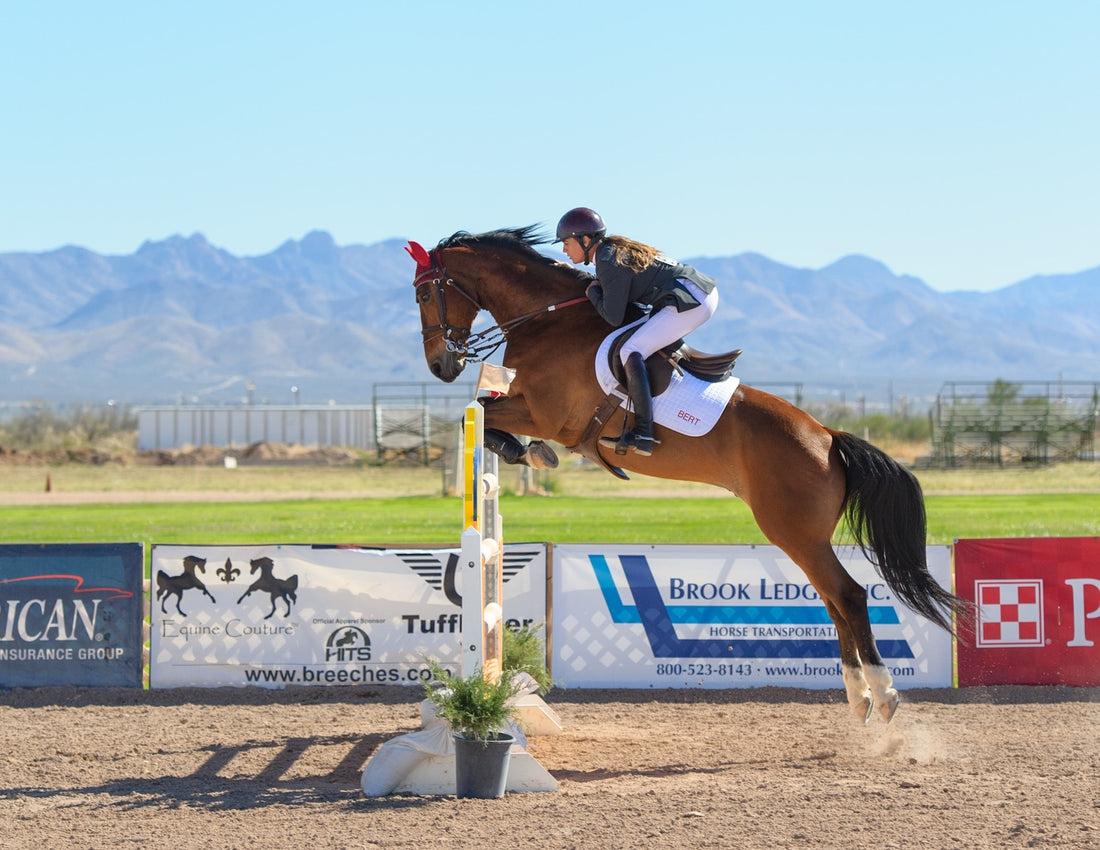
Show Jumping Tack: The Complete Tack List
Michelle DrumAs a show jumper, you’ve likely spent hours training and working with your horse to build both skill and trust while jumping. Along with trust and discipline, the right tack and saddlery are key for both horse and rider while show jumping. That’s why you want to make sure you equip your horse with the best tack possible to keep you both safe while you compete. In this guide, we’ll dive into the tack and equipment you’ll need to successfully and safely compete in a show jumping event.
What tack do you need for show jumping?
In show jumping, you and your horse need specific equipment and tack to compete effectively and safely. The FEI (Fédération Equestre Internationale) regulates the official guidelines regarding saddlery, equipment, and dress for show jumping events. The primary concern of the FEI regarding show jumping tack is the welfare and safety of both horses and riders.
The primary pieces of tack used in show jumping include:
1. Bits
The FEI allows most bit types during show jumping, including snaffle bits, gags, Pelham bits, and kimberwicks. Snaffle bits are one of the most popular bits because they’re gentle and flexible, but it never hurts to experiment with different bits to find what your horse responds best to. However, wire, double wire, or chain bits may not be used in show jumping events.
The choice of bit depends on factors such as your horse’s training level, temperament, and mouth conformation, as well as your skill level. When your horse is comfortable with a bit, its jaw, head, and neck are relaxed and the horse is responsive. If your horse is stiff and tense, it’s a good indicator that the bit is not suited for your horse. Choose a bit that is comfortable for your horse and easy for you to communicate with as you ride.
Learn more: How to Choose an English Horse Bit
2. Bridles
A bridle consists of a headpiece, browband, cheekpieces, throatlatch, noseband, and reins. The bridle, along with the bit, allows you to control your horse as you ride. Certain bridle styles are acceptable for show jumping.
- Snaffle Bridle: The most popular bridle in the jumper ring, especially when combined with a figure 8 noseband and rubber reins. The snaffle bridle is known for its mild action and direct communication. It allows the rider to have direct contact with the horse’s mouth, enabling precise communication and control.
- Double Bridle: A double bridle, also known as a Weymouth bridle or full bridle, is a specialized type of bridle consisting of two bits, the bradoon and the curb bit. It provides riders with more refined control and communication with their horses.
- Micklem Bridle: The Micklem bridle is a unique and innovative type of bridle designed with the horse’s comfort and well-being in mind. Its anatomical design fits your horse’s head shape more comfortably, and it’s shaped to avoid pressure points and sensitive areas, such as facial nerves, cheekbones, and sensitive mouth corners.
- Hackamore Bridle: A hackamore bridle, also known simply as a hackamore, is a type of bridle that does not use a bit to control the horse. Instead, it applies pressure to your horse’s face, nose, and chin to communicate cues and commands. It is an alternative to traditional bridles that use a bit.
Learn more: What is a Horse Bridle and How Does it Work?
3. Nosebands
The FEI guidelines emphasize the type of noseband you use, requiring at the CSI(O)P and CSI(O)Ch levels that it be flat and made of leather. Here are some commonly accepted noseband styles worn during show jumping competitions:
- Figure 8 noseband: Also known as a grackle, the figure 8 features a special noseband that crosses over your horse’s nose in a figure-eight pattern, avoiding pressure on your horse’s sensitive facial nerves. It is designed to help keep your horse’s mouth closed and prevent your horse from crossing its jaw or evading the bit.
- Cavesson noseband: A cavesson noseband offers stability and control, particularly for horses that require more support around the nose and face. A cavesson noseband is a traditional and versatile style used in various equestrian disciplines.
- Flash noseband: The primary purpose of a flash noseband is to provide additional stability and control by preventing your horse from opening its mouth too wide, crossing its jaw, or evading contact with the bit. It helps to keep the bit in a more stable position within your horse’s mouth and provides clearer and more consistent communication between horse and rider.
- Dropped noseband: A dropped noseband is a strap that encircles your horse’s nose below the cheekbones, sitting lower than other noseband styles. Dropped nosebands help keep your horse’s mouth closed and in contact with the bit. The dropped noseband is typically padded for added comfort and fastened using buckles or studs on both sides.
4. Jumping saddles
A jumping saddle is a close-contact saddle specifically designed for show jumping. Jumping saddles provide secure contact with your horse while jumping over fences.
Finding the right saddle is a matter of personal fit and comfort for both you and your horse. It’s advisable to work with a professional saddle fitter or a knowledgeable equestrian retailer to ensure the proper fit and suitability for your specific needs.
If you have questions about how to choose or how to measure a saddle, we’d love to help! The Farm House team is made up of experienced English riders who have a thorough understanding of saddle sizing.
Learn more: 10 Best Jumping Saddles
5. Girths
A girth, also known as a cinch, is fastened snugly around your horse’s belly to secure the jumping saddle on his body. Girths are typically made of thick and durable leather, synthetic materials, or a combination of both. They can have various designs, including straight or contoured to conform to the horse’s body.
Riders typically use jumping girths for their horse’s maximum comfort. Jumping girths are cut back around the horse’s elbows to prevent chafing. Many show jumpers use stud guard girths to add an extra layer of protection for the horse. Stud guards protect the horse’s belly against studs while jumping. Currently, the FEI has no restrictions or guidelines regarding girth types in show jumping events.
6. Stirrup leathers and stirrup irons
Stirrup leathers and stirrup irons are used to support your feet in the stirrups. Both types of equipment work together to provide stability, balance, and support while riding. When show jumping, it’s important to choose sturdy stirrup leathers and irons since you’ll be standing up quite a bit in the stirrups as your horse jumps.
The FEI has no specific rules regarding types of stirrup leathers, though safety stirrups or magnetic stirrups are recommended. The FEI also notes that the stirrup iron and the stirrup leather (including safety stirrups) must hang freely from the bar of the saddle and the outside of the flap–in short, the rider cannot attach themselves in any way to the stirrups or saddle.
Learn more: All About Stirrup Irons
7. Boots or bandages
Boots or bandages around your horse’s legs provide support and help prevent injuries from knocks or strikes against fences. Bandages and lightweight socks are acceptable for horses to wear during show jumping events, but the FEI is fairly strict about protective boots because certain styles tend to do more harm than good.
Both single-shell and double-shell hind boots are permitted. The general rule of thumb is that the boots must be designed in such a way that both sides can be bent to fit around your horse’s leg without effort. This means the boot should be pre-molded to fit around a horse’s fetlock. Boots must also be positioned so that the round, protective part of the boot is placed around the inside of the fetlock. Elastic fasteners are permitted, as well as stud/hook fasteners.
Learn more: The Rider’s Guide to Horse Boots
8. Martingales
Martingales are attachments that help control your horse’s head carriage. Running martingales are acceptable at all levels of show jumping and are most popular. Standing martingales are only acceptable in classes with jumps under 1.30m as they increase the likelihood that a horse might fall.
A running martingale consists of a strap that splits into two separate rein attachments. The strap passes through the bit rings or attaches to the reins, and then travels through a neck strap or a breastplate. The reins pass through rings on the end of the strap, creating a triangle-shaped rein configuration. This martingale encourages your horse to maintain a more vertical head carriage and prevents excessive head tossing or lifting. It provides a steady point of contact for your hands and helps to stabilize your horse’s head and neck.
A standing martingale consists of a strap that attaches to the girth or breastplate and runs up through the bit rings. It then splits into two or more pieces that join together in a central ring below your horse’s neck. The central ring usually has a loop or attachment for the reins to pass through. A standing martingale discourages your horse from raising its head too high or extending its neck too far. It encourages your horse to maintain a more contained head carriage and prevents you from losing control if your horse throws its head up suddenly.
Running martingales are acceptable for all categories of show jumping while standing martingales are only acceptable in the CSI(O)Ch category. Martingale stoppers are also permitted during show jumping events, though only one stopper per rein is permitted. Martingale stoppers cannot be configured to make a running martingale operate like a standing martingale.
Learn more: What is a Running Martingale and When Do You Need It?
9. Breastplates
A breastplate is optional but commonly used in show jumping. It attaches to the saddle’s D-rings and runs across your horse’s chest, helping to prevent the saddle from sliding back during jumps. The breastplate is typically attached to the saddle as well as a running martingale if one is in use. The FEI does not have any restrictions in place regarding the use of a breastplate, so using one is at your discretion.
It’s important to note that while some pieces of tack are required, such as a saddle, bridle, and reins, other pieces of equipment are entirely optional. We recommend starting with the bare minimum and add on tack as needed. Always pay attention to your horse’s comfort level and only use tack that your horse responds well to. A comfortable horse is more likely to listen and perform well both in training and in competition.
Gearing up with the proper equipment protects you and your horse as you navigate challenging courses with jumps of varying heights and technicality. Falls can happen, but wearing safety equipment, including a reliable riding helmet and safety vest, minimizes the risk of injury and helps you ride confidently. Learn how to prevent injury if you fall off your horse.
At Farmhouse Tack, we have everything you need to outfit both you and your horse for show jumping. Browse our selection of tack and riding apparel to get competition-ready today!
You might also like:

1 comment
Hey! Thank you for doing this. I’m currently transitioning from Dressage to Showjumping.
So, if you have any tips, please let me know!